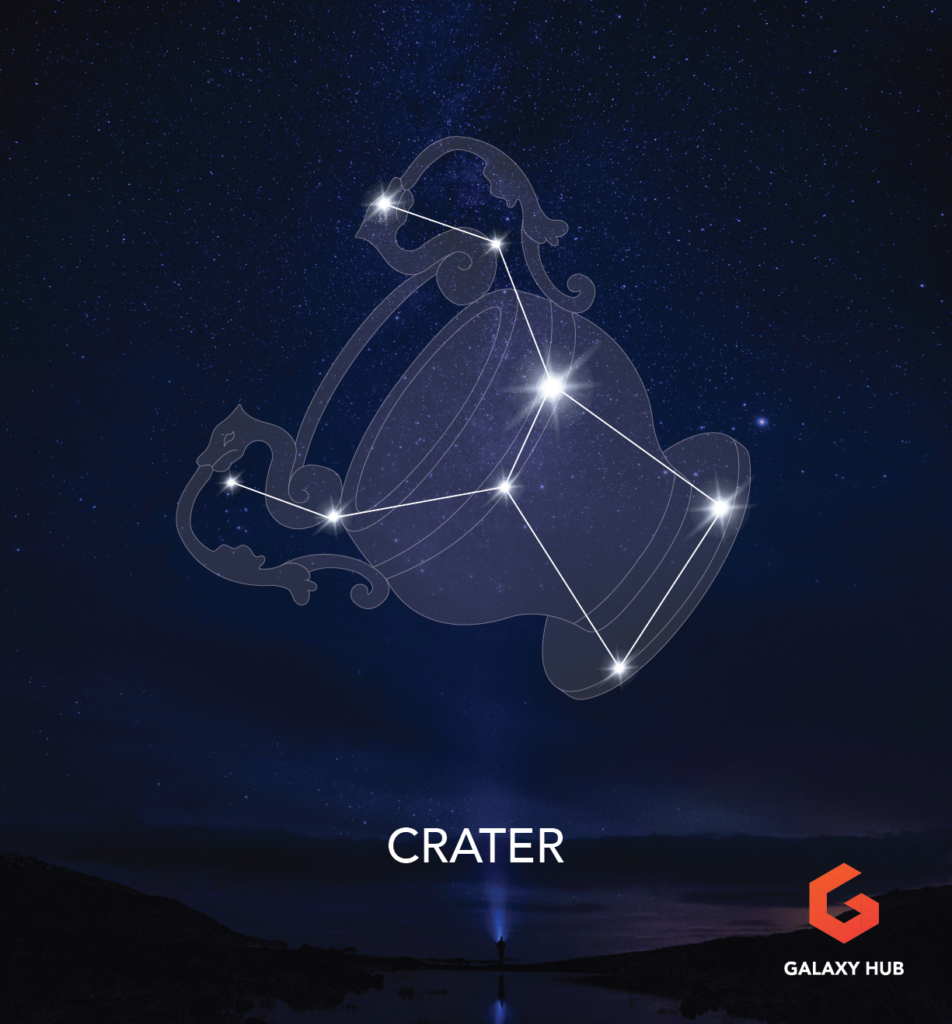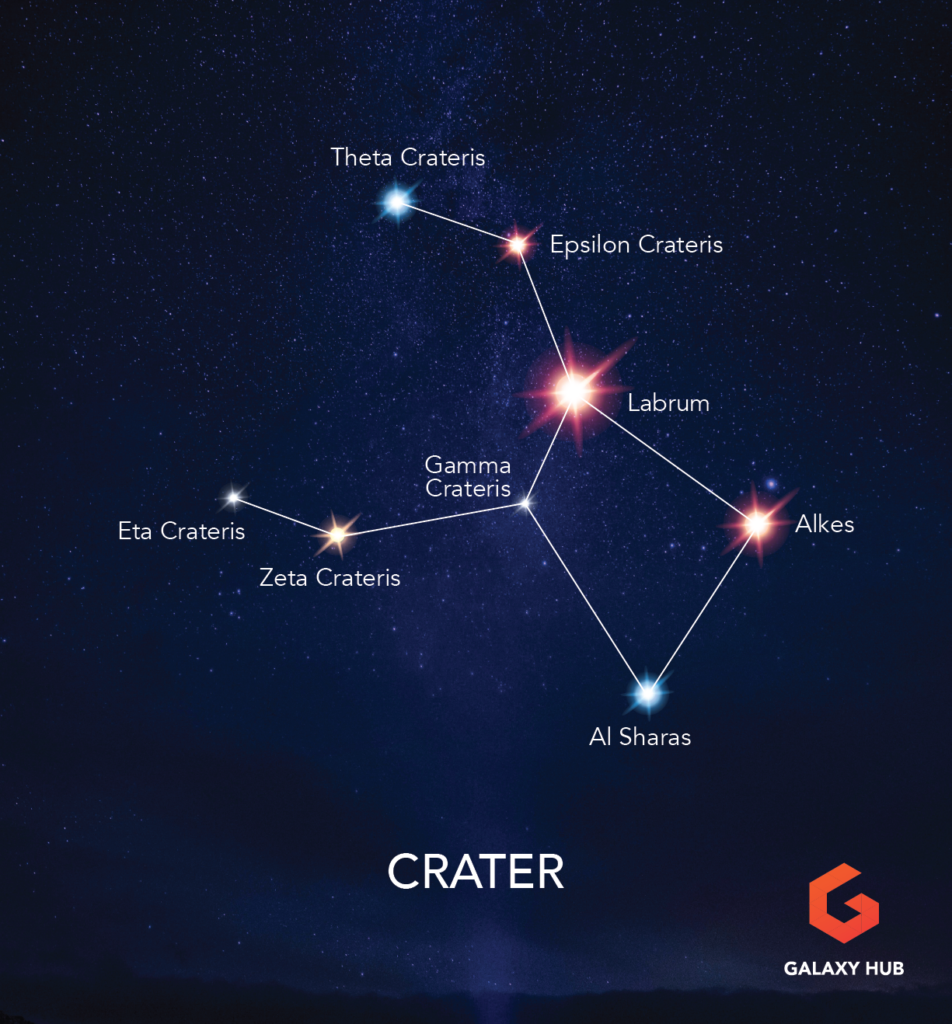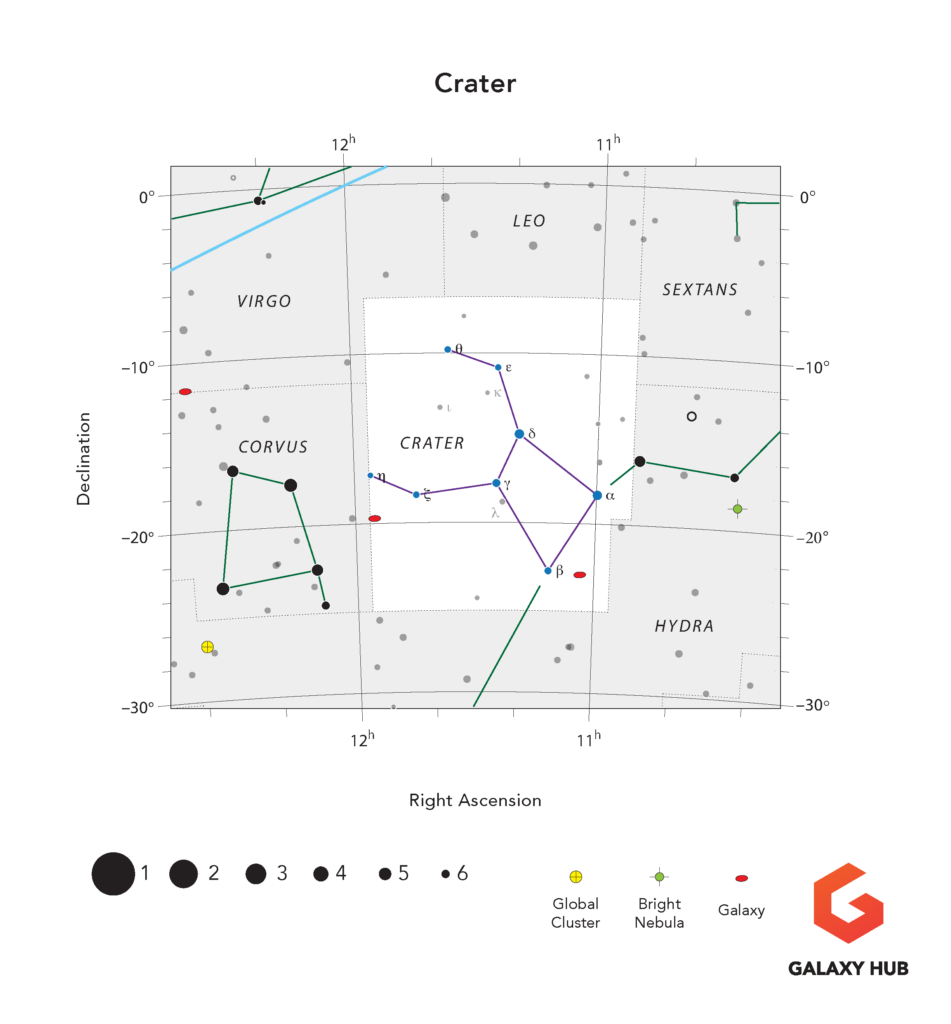
Crater is a small, cup-shaped constellation consisting of four stars in the Southern Sky. It is bordered by the constellations of Hydra, Corvus, and Sextans, as well as the Zodiac constellations Leo and Virgo. Crater’s position just below the ecliptic plane – the line that the sun, moon, and planets traverse in the sky – makes it fairly easy to locate.
One of Ptolemy’s 48 designated constellations, Crater is best observed in the spring. For those looking to catch the meteor shower associated with the star Eta Crateris, mid-January is another ideal time to observe. While Crater only possesses one star brighter than a magnitude 4, it contains several notable deep sky objects.
Want to get started in astronomy?
Our free telescope cheat sheet breaks down the key factors to choosing a telescope and shows you how to get stunning views of planets, nebula, and galaxies!

Crater Key Data
Name
| Latin | English | Pronunciation | Genitive | Abbreviation |
| Crater | The Cup | cray-ter | Crateris | Crt |
Location
| Hemisphere | Best Seen | R.A. | Declination |
| Southern | April | 10h 51m to 11h 56m | -6.66° to -25.20° |
Features
| Area | Size Rank | # of Messier Objects | # of Stars Brighter than Mag 4 | Brightest Star |
| 282 sq. Deg. | 53rd | 0 | 1 | Delta Crateris, mag 3.56 |
Top Crater Facts
- The constellation is home to the Eta Craterids meteor shower, which peaks on January 16th each year
- Crater is home to a quasar that contains a black hole whose spin was the first ever to be measured
- Crater contains the Crater 2 dwarf galaxy – a satellite galaxy to our own Milky Way
- A well known gamma ray burst occurred in 2001 in the Crater constellation. It was the longest one detected by the Italian BeppoSAX satellite to date
Crater in Mythology

In ancient Babylon, Crater – along with neighbors Corvus and Hydra – may have been considered a symbol of death and a gate to the underworld. The name Crater comes from the Greek word krater, which is a type of cup that was used to dilute wine. The constellation is part of two distinct Greek myths, each providing a different origin story.
The first Greek myth involves Crater’s neighboring constellations, Corvus and Hydra, as well as the sun god Apollo. The story goes that the raven was tasked with bringing back water to Apollo in a cup. After several delays, the raven brought back the cup and a water snake, and blamed the snake for drinking the water en route to Apollo. Angry at the raven’s lies, Apollo then hurled the snake, the raven, and the cup into the sky. They remain next to each other in the sky to this day, and the cup lies just out of reach of the raven – serving as a warning to anyone who would dare to disobey Apollo.
A different and darker myth involving Crater was presented by the Greek historian Phylarcus. The story was set in Eleusa, a city near Troy that was suffering from a plague. In an attempt to rid the city of plague, its ruler held a yearly lottery in which a maiden was chosen for sacrifice. However, the leader excluded his own daughters from the lottery. A nobleman who objected to this killed the leader’s daughters and tricked him into drinking their blood, mixed with wine. Crater was the cup from which this mixture was imbibed, and when the leader found out what he had ingested, he angrily cast the cup into the sea.
Crater in History
In ancient Babylon, the stars of Crater’s cup are thought to have been considered part of the neighboring constellation of Corvus, the raven. Alongside Corvus once again, Crater was pictured in iconography associated with Mithraism, an ancient Greek and Roman religion.
It was also featured in Urania’s Mirror, a set of 32 star chart cards depicting constellations. Here, Crater was shown as a gold, double-handled chalice. The constellation’s official boundaries were delineated in 1930 by Belgian astronomer Eugene Delporte.
Want to get started in astronomy?
Our free telescope cheat sheet breaks down the key factors to choosing a telescope and shows you how to get stunning views of planets, nebula, and galaxies!

When and How to See Crater
Crater lies just below the Zodiac constellations of Leo and Virgo, which makes it an easy target. Leo’s head is shaped like a backwards question mark, and observers can locate the cup to the by looking below and to the left of Leo’s head in the sky. Crater lies just below the ecliptic plane, which means that planets may sometimes be located not too far above the constellation in the sky. If a planet is in Leo or Virgo, it can act as a convenient marker to locate the cup.
Alternatively, if observers can locate the constellation of Hydra, the serpent, Crater is a chalice-shaped group of stars that appears to be riding on the snake’s back. Crater’s three brightest stars (Delta, Alpha, and Gamma Crateris) all form a triangle near the star Nu Hydrae.
Observers from the south pole to 65 degrees latitude can view Crater. It’s best observed in the spring, particularly the month of April. However, one of the most exciting moments to observe crater is during the Eta Crateris meteor shower in the winter. This occurs from around January 11th to January 22nd and peaks around January 16th or 17th each year. To see the meteor shower, locate the star Eta Crateris, which makes a right triangle in the sky with Zeta Crateris and 31 Crateris. In this triangle, Eta Crateris will be the right angle. With a magnitude of 5.17, the star is faint and will only be visible to the naked eye in very dark skies.
Crater’s Notable Stars

| Bayer/Gould Designation | Name (s) | Mag | R.A. | Dec. | Distance (LY) | Notes |
| Alpha | Alkes | 4.07 | 10h 59m 46s | -18° 17’ 56” | 174 | An orange giant and suspected horizontal-branch star |
| Beta | Beta Crateris | 4.46 | 11h 11m 39s | -22° 39’ 33” | 296 | An astrometric binary star system containing a white dwarf and a giant |
| Delta | Delta Crateris | 3.56 | 11h 19m 20s | -14° 46’ 43” | 163 | The brightest star in the Crateris |
| Gamma | Gamma Crateris | 4.06 | 11h 24m 53s | -17° 41’ 02” | 86 | Binary star system whose component stars can be viewed with a small telescope |
| Eta | Eta Crateris | 5.17 | 11h 56m 01s | -17° 09’ 03” | 251 | A faint main sequence star and the apparent source of the Eta Crateris meteor shower |
Alpha Crateris – Alkes
Alkes is one of the main stars of Crater, located close to the constellation of Hydra. In fact, Alkes along with several other stars in Crater and Hydra form a Chinese asterism whose name translates as “Wings” – and the name for Alpha Crateris specifically translates as the “first star of wings.”
An orange giant star about 12 times as large and 66 times as luminous as the sun, Alkes is a fairly unique star. Astronomers believe that it is a horizontal-branch star, which means that it experienced a helium flash and subsequently began fusing helium in its core.
Beta Crateris
Once considered part of the ribs of the neighboring constellation Hydra by astronomer Al Tizini, Beta Crateris is Crater’s makes up the lower left portion of the cup. Beta Crateris is actually two stars bound together gravitationally in what’s known as an astrometric binary system. Its components, a giant star and white dwarf, are only 8.3 Astronomical Units apart and have an orbital period of 6 years.
The white dwarf is noteworthy for a few reasons. First, it has a high temperature of 36,885 Kelvin and emits X-ray radiation. Second, its mass is surprisingly low – less than half the mass of the sun. This, along with enhanced barium lines in its companion star’s spectrum, suggests to scientists that it may have transferred some of its matter to the giant star.
Delta Crateris
The brightest star in the constellation, Delta Crateris is about 1.5 times as massive as the sun, but has swelled up to around 22 times the sun’s radius. The orange giant star is fusing helium in its core, and one notable characteristic is its rotational velocity, which is considered to be 0 km/s since it is too slow to measure. This star has been referred to traditionally as Labrum, but that is not considered its official name.
Gamma Crateris
Gamma Crateris is a binary star system in the center of Crater’s constellation space. It’s a great target for those with small telescopes, since even those will show that the system is comprised of two stars.
The first star in the binary is a main sequence star of magnitude 4.08. It’s rotating at 144 km/s and data suggests that the star may have a disk of debris orbiting it, but this has not been confirmed.
The second star in the binary is magnitude 9.6, so a telescope is needed to distinguish it. It can be found at an angular separation of 4.98 arcseconds to the primary star, and is likely the source of X-ray emission that scientists have detected from the pair of stars.
Eta Crateris
Unlike the other stars on this list, Eta Crateris is not really a part of the constellation’s main shape. It is also fairly faint, so it can only be spotted in very dark skies. It is noteworthy, however, as this is the star observers will want to find if they are seeking to view the Eta Crateris meteor shower, which peaks around January 16th and 17th annually.
The main sequence star is located on the border of the delineated space of Crater and its neighboring constellation Corvus. If one were to draw a line between Gamma Corvi and Gamma Crateris, Eta Crateris would be near the center point of that line, slightly closer to Gamma Corvi. It also makes a right triangle in the sky with Zeta Crateris and 31 Crateris.
Crater’s Deep Sky Objects

| Object | Name(s) | Type | Mag | R.A. | Dec. | Distance (LY) | Min. Equipment |
| Crater 2 | Crater 2 | Dwarf galaxy | 12.15 | 11h 49m 14s | -18° 24’ 47” | 380000 | Medium telescope |
| NGC 3511 | N/A | Spiral Galaxy | 10.8 | 11h 03m 24s | -23° 05’ 12” | 41.5 million | Medium Telescope |
| NGC 3981 | N/A | Spiral Galaxy | 11.75 | 11h 56m 07s | -19° 53’ 46” | 62 million | Medium Telescope |
Galaxies
Crater 2 is the fourth largest satellite galaxy surrounding our own Milky Way galaxy. Its angular size is double that of the moon, making it a fairly diffuse dwarf galaxy. Despite the fact that it is part of the Local Group of galaxies and orbits the Milky Way, Crater 2 has low brightness and was only discovered in 2016! Because it is dim and diffuse, it is harder to observe than some of the Milky Way’s other satellite galaxies.
NGC 3511 is an intermediately sized spiral galaxy that was discovered in the late 1700s by William Herschel. At 70,000 light years across, its spiral arms are diffuse and divided by dark lanes of dust. To find this galaxy, which can be seen at an inclination of about 70 degrees, observers should look two degrees west of Beta Crateris.
NGC 3981 is a spiral galaxy that was also discovered in the late 1700s by William Herschel. It is part of the Virgo Supercluster and is located near the celestial equator, making it visible from both hemispheres at different parts of the year. The galaxy is inclined toward Earth, which provides a stunning, head-on view for observers with strong enough telescopes.
